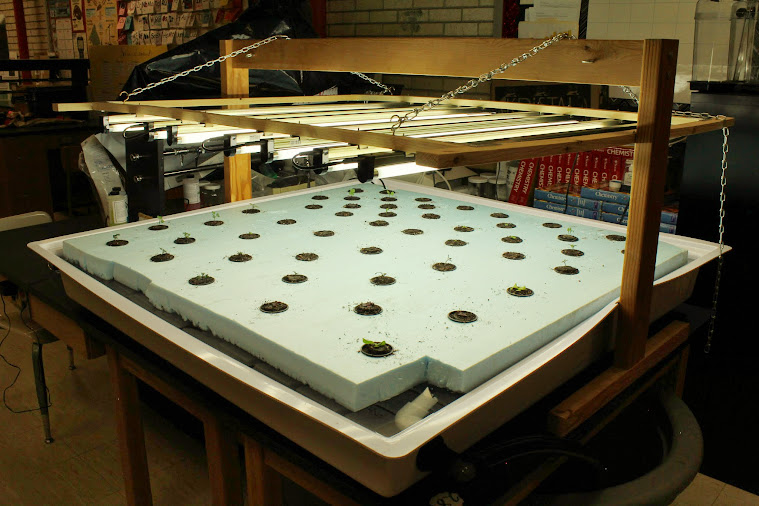
15 Feb Want to Build Your Own?
The worldwide issue of food security and sustainable food production is complex and multifaceted. Want to model a sustainable solution?
Since being completely consumed with modeling sustainable food production through aquaponics during their 2014 summer term at ISB, a few brave teachers embarked on a journey throughout this school year…designing, building, and maintaining their own classroom aquaponics system. Interested in trying it with us? Below, we’ve documented a few of our strategies in the hopes of helping you to successfully begin your own aquaponics journey!
My name is Jessica Day. As a second year high school science teacher and lover of all things research-related, I made it a personal goal to create an aquaponics system with my AP Environmental Science students in Amarillo, TX as soon as I finished working with ISB in 2014. I am devoted to learning new, innovative, sustainable ways to produce food for communities like ours that reside in drought-stricken, agriculturally-drained regions. Did you know that every county in the United States has at least one “food desert,” where people are unable to obtain enough of the right types of food to be healthy (either because of a lack of money or transportation)? My students and I researched our local food data (average price per meal, percent of individuals qualifying for food aid, and food desert locations) and agricultural issues (soil type, climate, irrigation), and discussed ways we could help others grow their own food. With the gracious financial support of my principal, I was given the green light to jump right in. Based on research and the advice of local aquaponics gurus, I decided to use the deep water culture method in a 4ft x 4ft area of my classroom.
Click for the 4′ x 4′ TX Design Materials, the Tools Needed, and the Drawings that you can use to create the same system!
What’s so great about growing plants in this system?
- I’m saving water (about 95%) that would otherwise be lost to groundwater and runoff with traditional soil gardening techniques. This turns out to be a great educational topic, especially in areas experiencing drought.
- I can plant produce extremely close together as all roots have a constant nutrient source in the water. In traditional gardening, soil would only provide nutrients in the area immediately surrounding each plant. At the rate we’re losing topsoil, this is a pretty attractive option.
- Almost any plant does well in this system and grows FAST! Flowering plants, fruiting plants, root vegetables, leafy greens, herbs…you name it! We’re currently experimenting with broccoli, radish, tomato, cilantro, basil, cayenne pepper, lettuce, kale, spinach, carrot, rosemary, and chive.
- My students are truly invested in the well-being of the plants. They’ve watched them grow from seeds and are excited to see their progress every day. I think any teacher would agree that consistent student engagement of this kind is pretty incredible!
Previously…
At the moment, we’re anxiously awaiting the arrival of our systems’ Ammonia supply – Mozambique Tilapia fingerlings! Within the next week, we will be the proud parents of 50 fish that will be placed in the 100 gallon stock tank located under our grow bed. With this new influx of ammonia, our Nitrogen-fixing bacteria (Nitrosomona and Nitrobacter) will happily convert the ammonia released as feces from the fish into a healthy, natural food source for our plants (Nitrate). We’ve added a healthy amount of bacteria from another fully-cycled aquaponics system, but you can also add bacteria in this form to start your system. Typically, the fish (ammonia source) and bacteria (nitrogen fixer) can be added at the same time, but the seeds should be planted a few weeks earlier to begin root formation.
What were up to now…
In March 2015, we finally added our 50 fish friends to our system. They are still growing quickly and have made the system much more productive; however, this system now has a new caretaker! I have moved to Seattle to work full-time with the Institute for Systems biology and support teachers and students in developing their own aquaponics systems. If you’re a teacher interested in building your own classroom system and teaching your students about food security, please contact Jessica Day at jday@systemsbiology.org.
Design Challenge!
Here at ISB, we welcome innovative thinkers and lifelong learners! Here you have an opportunity to submit your own innovative design ideas and get feedback from experts at ISB.
We have also attached the ISB 2×4 Design Guide and the 2′ x 4′ ISB Design Materials if you’re interested in testing our design in your own classroom or home!
Please submit any designs to: jday@systemsbiology.org















Sorry, the comment form is closed at this time.